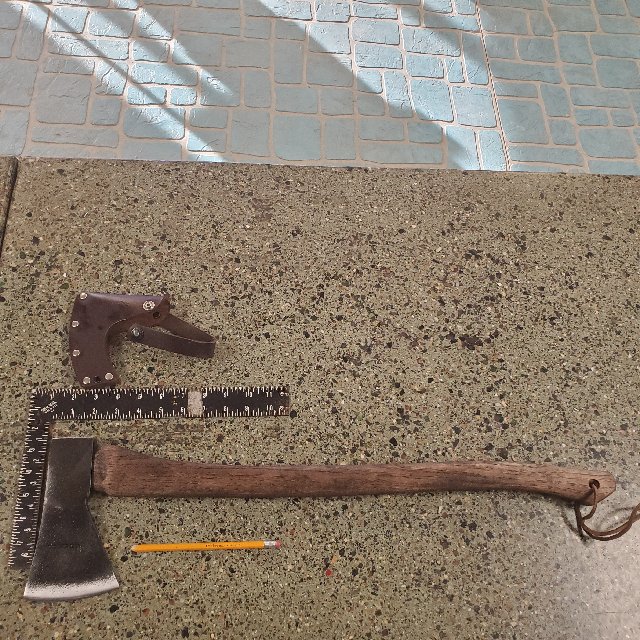- Joined
- May 9, 2002
- Messages
- 12,649
Howdy, y'all.
After years and years of hatchet a tomahawk collecting, I have started to find myself drawn to the idea of an axe for general "whatever" chores. My LGS had a Condor Greenland axe sitting over in the corner, and I decided it needed to come home with me. This particular model Sports a 2.5lbs head married to a 26" boy's axe handle. It seems like a decent bridge between the tomahawks I have carried out and about in the woods and the 32" splitting axe I keep at home for fire wood.
Let's just call this a "truck axe". It has no specialized purpose. I won't be Bushcrafting with it. I won't be using it to quarter an elk. This is just going to be a tool that may get brought out from under the back seat to cut up a small dead tree down at my stepdad's cabin or to break up a bit of firewood on a very comfortable tent camping trip.
So my long winded question to you much more learned folks, given my projected usage how sharp should I keep this axe...in your opinions? It came with an edge just north of "butterknife". Being that I'm a khukuri guy, I'm pretty comfortable roughing in an edge with a file and then conveying it with a sanding sponge/paper and a leather strop. So far, I've got it about as sharp as I keep my hawks. Nice beefy edge that will bite deep yet keep its structural integrity if pushed. It won't shave, but I can push the head down with my hands and easily cut through a piece of 8oz leather cleanly. However, this is the first axe I have ever owned that wasn't a small kindling hatchet or a splitting axe. It comes with a really nice protective sheath, so in theory I could hone this to a razor's edge and transport it safely.
What do y'all think? Keep the working edge and let it go at that or take it skinny and turn it into a razor blade? I could see it both ways. The practical side of me says it's just fine how it is. The other side of me says that it won't see much use, so why not thin it to scary sharp.
Thoughts? Thanks in advance.

Here's a pic of it. I gave it a good sanding, and I tossed on some darker stain to "age" the wood a bit, make it look like one that got left in the splitting stump every winter. The wood looks might thirsty. I'll probably burn some runes into it for fun and give it a soak in oil to plump up the wood a bit.
This is a cheap project axe. One part, make it useful. One part, whatever makes it unique that doesn't interfere with the first part.
After years and years of hatchet a tomahawk collecting, I have started to find myself drawn to the idea of an axe for general "whatever" chores. My LGS had a Condor Greenland axe sitting over in the corner, and I decided it needed to come home with me. This particular model Sports a 2.5lbs head married to a 26" boy's axe handle. It seems like a decent bridge between the tomahawks I have carried out and about in the woods and the 32" splitting axe I keep at home for fire wood.
Let's just call this a "truck axe". It has no specialized purpose. I won't be Bushcrafting with it. I won't be using it to quarter an elk. This is just going to be a tool that may get brought out from under the back seat to cut up a small dead tree down at my stepdad's cabin or to break up a bit of firewood on a very comfortable tent camping trip.
So my long winded question to you much more learned folks, given my projected usage how sharp should I keep this axe...in your opinions? It came with an edge just north of "butterknife". Being that I'm a khukuri guy, I'm pretty comfortable roughing in an edge with a file and then conveying it with a sanding sponge/paper and a leather strop. So far, I've got it about as sharp as I keep my hawks. Nice beefy edge that will bite deep yet keep its structural integrity if pushed. It won't shave, but I can push the head down with my hands and easily cut through a piece of 8oz leather cleanly. However, this is the first axe I have ever owned that wasn't a small kindling hatchet or a splitting axe. It comes with a really nice protective sheath, so in theory I could hone this to a razor's edge and transport it safely.
What do y'all think? Keep the working edge and let it go at that or take it skinny and turn it into a razor blade? I could see it both ways. The practical side of me says it's just fine how it is. The other side of me says that it won't see much use, so why not thin it to scary sharp.
Thoughts? Thanks in advance.

Here's a pic of it. I gave it a good sanding, and I tossed on some darker stain to "age" the wood a bit, make it look like one that got left in the splitting stump every winter. The wood looks might thirsty. I'll probably burn some runes into it for fun and give it a soak in oil to plump up the wood a bit.
This is a cheap project axe. One part, make it useful. One part, whatever makes it unique that doesn't interfere with the first part.



